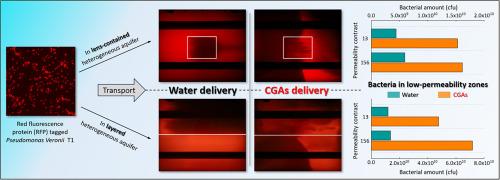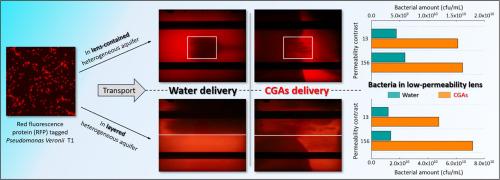非均质含水层中胶态气aphrons增强细菌运输:性能评价和机理见解
IF 12.4
1区 环境科学与生态学
Q1 ENGINEERING, ENVIRONMENTAL
引用次数: 0
摘要
地质异质性限制了外源功能微生物在含水层中的迁移和分布,从而降低了生物强化对地下水修复的效果。本研究将Tween80胶态气aphrons (CGAs)作为非均质含水层微生物输送的有效载体。采用红色荧光蛋白(RFP)标记法实时、无创地跟踪细菌在二维(2-D)模拟含水层系统中的迁移。结果表明,CGAs与模型菌株维罗尼假单胞菌T1保持稳定的细菌活力、均匀的细胞分散和同步的共运输。负载细菌的CGAs在饱和砂质介质中实现了有效的渗透和高效的细菌运输,随着介质尺寸的增大和注入速率的提高,迁移距离增加。在渗透率对比为10 - 102的非均质含水层中,CGAs使低渗透层(细砂或粉砂)的细菌流入量增加了2.71- 4.99倍。对于小的低渗透透镜,细菌负载的CGAs的剪切变薄特性使它们能够直接穿透。对于较大的低渗透层,CGAs在跨层进入时坍塌,释放出细菌悬浮液,随后这些细菌悬浮液迁移到这些具有挑战性的区域,并显着增强了细菌在其中的传递。此外,CGAs大大提高了含水层的含氧量,潜在地支持地下水中污染物的好氧生物降解。这些发现为加强地下水生物修复提供了有价值的理论见解和实践策略。本文章由计算机程序翻译,如有差异,请以英文原文为准。


Bacterial transport enhancement by colloidal gas aphrons in heterogeneous aquifers: Performance evaluation and mechanistic insights
Geological heterogeneity limits the transport and distribution of exogenous functional microbes in aquifers, thereby reducing the efficacy of bioaugmentation for groundwater remediation. This study introduced Tween80 colloidal gas aphrons (CGAs) as efficient carriers to enhance microbial delivery in heterogeneous aquifers. Red fluorescent protein (RFP)-tagging method was used for the real-time, non-invasive tracking of bacterial transport in two-dimensional (2-D) simulated aquifer systems. The results show that CGAs maintained robust bacterial viability, uniform cell dispersion, and synchronized co-transport with the model strain Pseudomonas veronii T1. Bacteria-laden CGAs achieved effective penetration and efficient bacterial transport in saturated sandy media, with migration distance increasing with larger media size and higher injection rates. In heterogeneous aquifers with permeability contrasts ranging from 10 to 102, CGAs boosted bacterial influx in low-permeability zones (fine or silt sand) by 2.71- to 4.99-fold. For small low-permeability lenses, the shear-thinning property of bacteria-laden CGAs enabled their direct penetration. For larger low-permeability layers, CGAs collapsed upon cross-layer entry, releasing bacterial suspensions that subsequently migrated into these challenging zones and markedly enhanced bacterial delivery within them. Additionally, CGAs substantially raised aquifer oxygen levels, potentially supporting aerobic biodegradation of pollutants in groundwater. These findings provide valuable theoretical insights and practical strategies for enhancing groundwater bioremediation.
求助全文
通过发布文献求助,成功后即可免费获取论文全文。
去求助
来源期刊

Water Research
环境科学-工程:环境
CiteScore
20.80
自引率
9.40%
发文量
1307
审稿时长
38 days
期刊介绍:
Water Research, along with its open access companion journal Water Research X, serves as a platform for publishing original research papers covering various aspects of the science and technology related to the anthropogenic water cycle, water quality, and its management worldwide. The audience targeted by the journal comprises biologists, chemical engineers, chemists, civil engineers, environmental engineers, limnologists, and microbiologists. The scope of the journal include:
•Treatment processes for water and wastewaters (municipal, agricultural, industrial, and on-site treatment), including resource recovery and residuals management;
•Urban hydrology including sewer systems, stormwater management, and green infrastructure;
•Drinking water treatment and distribution;
•Potable and non-potable water reuse;
•Sanitation, public health, and risk assessment;
•Anaerobic digestion, solid and hazardous waste management, including source characterization and the effects and control of leachates and gaseous emissions;
•Contaminants (chemical, microbial, anthropogenic particles such as nanoparticles or microplastics) and related water quality sensing, monitoring, fate, and assessment;
•Anthropogenic impacts on inland, tidal, coastal and urban waters, focusing on surface and ground waters, and point and non-point sources of pollution;
•Environmental restoration, linked to surface water, groundwater and groundwater remediation;
•Analysis of the interfaces between sediments and water, and between water and atmosphere, focusing specifically on anthropogenic impacts;
•Mathematical modelling, systems analysis, machine learning, and beneficial use of big data related to the anthropogenic water cycle;
•Socio-economic, policy, and regulations studies.
 求助内容:
求助内容: 应助结果提醒方式:
应助结果提醒方式:


